Seed Exchange Networks of Native Maize, Beans, and Squash in San Juan Ixtenco and San Luis Huamantla, Tlaxcala, Mexico
Abstract
:1. Introduction
2. Materials and Methods
2.1. Study Zone
2.2. Description of Study Sites
2.3. Interviews with Farmers
2.4. Questionnaires Applied to Farmers
2.5. Analysis of the Seed Networks
3. Results
3.1. Agricultural Crops Registered in Ixtenco and Huamantla
3.2. Maize Exchange Network
3.3. Bean Exchange Network
3.4. Squash Exchange Network
3.5. Seed Exchange among Farmers from Ixtenco and Huamantla
“We’ve been very careful about caring for[seeds], although on some occasions the weather hasn’t favored us. For example, in 2011, due to frost, seed was lost out in the entire region. In 2012 we had planted, but also it came to frost when we’d reestablished [the crops of] 90% of the entire region of Huamantla and its 39 communities. So we were in need of going to bring creole seeds from near [the volcano] the Malinche and on the other side of Puebla, and we again recovered creole seeds”.Farmer from Huamantla, 26 April 2019
“[Seeds] of colors we plant practically for mosaic made seed grains to exchange among each other, because some dedicate themselves to making figures, well more than figures, necklaces, earrings, some things with cornhusk, so for this, [we need] colored maize”.Farmer from Ixtenco, 12 November 2018
3.6. Maize, Bean, and Squash Exchange Networks and Conservation of Crop Diversity
4. Discussion
4.1. Structure of Seed Exchange Networks
4.2. Fragmented Exchange Networks
4.3. Local Market and Seed Bank in the Exchange Networks
5. Conclusions
Author Contributions
Funding
Institutional Review Board Statement
Informed Consent Statement
Data Availability Statement
Acknowledgments
Conflicts of Interest
Appendix A
- Native seed networks
- 1.
- How many plots do you have and what do you grow in each of them?
- 2.
- What is the total surface area of your plots?
- 3.
- Describe each plot (surface area, location, soil type, climate).
- 4.
- Why do you cultivate these plots?
- 5.
- Are the plots you cultivate your own or do you rent them?
- 6.
- [If rented:] How much do you pay for rent?
- Maize
- 7.
- Where do you obtain the seed for each variety of maize you plant (friend, neighbor, family member, market, save own seeds, etc.)?
- 8.
- Do you always obtain seed from this source/these sources? Why?
- 9.
- How long have you been conserving these seeds?
- 10.
- Why do you like cultivate each variety?
- 11.
- Why do you prefer to plant these varieties and not others?
- 12.
- What do you use each variety for?
- 13.
- Would you try planting other varieties? Why?
- Beans and Squash
- 14.
- Do you plant squash and beans?
- 15.
- Where do you obtain squash and bean seeds?
- 16.
- Since when do you have the seeds?
- 17.
- What varieties of squash and beans do you have? Name of the squash and beans varieties
- 18.
- Do you plant beans and squash the same time as maize?
- 19.
- Is the maize, bean, and squash seed you produce for self-consumption, sale, or both?
- 20.
- How many months does the maize you harvest for your family last?
- 21.
- How many months do the beans and squash last your family?
- 22.
- Can you tell us the names of all the people you have ever given maize, bean, and squash seed?
- 23.
- Can you name the people that have given you maize, bean, and squash seed?
- 24.
- Last season, did anyone give you seeds to plant? Why?
- Preparing the land for planting
- 25.
- How do you prepare the land for planting?
- 26.
- When does maize planting begin (for each variety)?
- 27.
- How long does it take for the cob to fully form (for each variety)?
- 28.
- When do you begin to plant beans (each variety)?
- 29.
- When do you begin to plant squash (each variety)?
- 30.
- How many harvests of maize do you have per year?
- 31.
- In the first, how much do you harvest? In the second?
- 32.
- How do you control weeds?
- 33.
- Do you use fertilizer/herbicide?
- 34.
- How much does the herbicide cost?
- 35.
- How much does the fertilizer cost?
- 36.
- Which family members plant?
- 37.
- Do women participate in agriculture? What do they help with? When you are not there, do they help with agriculture?
- 38.
- Do women select seeds? Do they exchange seeds?
- 39.
- When women marry, do they inherit seed?
- 40.
- Within the community, are there people who leave seed as inheritance? Have you received seed as inheritance?
- 41.
- What crops do you plant besides maize, beans, and squash?
- 42.
- Do you have animals? How many cattle? What do you give them to eat?
- 43.
- Do you carry out any income generating activities aside from agriculture?
- Seed loss, storage, and pests
- 44.
- Have you ever lost your maize, bean, or squash seed? If so, how (frost, poor harvest, etc.)? What variety?
- 45.
- How do you recover lost seed? Who do you ask for seed? Do you purchase it? Does someone lend it to you? Who?
- 46.
- Do you return borrowed seed? The same seed and the same quantity? Or do you return the favor by giving another variety of seed that they lent to you?
- 47.
- Do you or have you had problems with any maize, bean, or squash pest? Which pests? How do you control them?
- Seed sale
- 48.
- Do you sell seed?
- 49.
- If so, to whom? What price?
- 50.
- Do you know the destination of this seed?
- Organization and seed laws
- 51.
- Do you belong to any farmers’ organization?
- 52.
- Do you know of the Law to foment and protect maize as original heritage, in constant food diversification for the State of Tlaxcala?
- 53.
- Do you know of the Law of Production, Certification, and Commerce of Seeds or the Law of Plant Varieties?
- Festivities related to seeds
- 54.
- What do maize, beans, and squash mean to you?
- 55.
- Do you participate in any festivity of maize, beans, and squash?
- 56.
- In this municipality, the people carry out maize, beans, and squash fairs? When?
- Hybrid seed
- 57.
- Do you plant any hybrid seeds? Why?
- 58.
- Which hybrid seeds do you purchase?
- 59.
- Where do you purchase them?
- 60.
- What amount of hybrid seed do you purchase? By kilo, bag, or sack?
- 61.
- Are the seeds certified?
- 62.
- How much do you pay for hybrid seed?
- 63.
- Do you receive any subsidy for seed purchase? If so, how much?
- 64.
- What characteristics do these seeds have? What do you consider their advantages to be?
- 65.
- Do you use fertilizer to cultivate these seeds?
- 66.
- Do you sell the crops cultivated with these seeds? Do you conserve some seed for the following planting?
- 67.
- If you sell seed, to whom? At what price?
- 68.
- Do you know the destination of these seeds?
- 69.
- Do you replant these seeds for harvest?
- 70.
- In what cases do you replant these seeds for harvest?
| Questionnaire on seed networks |
| Date: State: Municipality: Farmer name: Gender: Male Female Age: Notes: How many plots do you have? For each plot: Surface area: Type (irrigated/seasonal): Elevation (high, medium, low): What quantity of seed do you need to plant the plot? |
| MAIZE |
| How many varieties of maize do you have? Which varieties? For each variety How long have you had it? Who gave it to you (family member, friend, neighbor, acquaintance? Other: What do you like about this variety? Have you ever lost it? YES/NO How? Frost Drought Hail Pests Other: How did you recover it and when? By purchase or gift? If gift, who gave it to you? Was it lent to you? If borrowed, from whom? Which of these varieties is the most important to you and why? During the past 5 years Have you exchanged/sold/gifted/lent any of your maize varieties during the past 5 years? YES/NO Which ones? With whom have you exchanged/sold/gifted/lent it/them? Friend ( ) Neighbor ( ) Family member ( ) Other: What amount of seed did you exchange/sell/gift/lend? Since when have you exchanged/sold/gifted/lent this seed? |
| BEAN |
| How many bean varieties do you have? Which varieties? For each variety: How long have you had it? Who gave it to you (family member, friend, neighbor, acquaintance? Other: What do you like about this variety? Have you ever lost it? YES/NO How? Frost Drought Hail Pest Other: How did you recover it and when? By purchase or gift? If gift, who gave it to you? Was it lent to you? If borrowed, from whom? Which of these varieties is the most important to you and why? During the past 5 years Have you exchanged/sold/gifted/lent any of your maize varieties during the past 5 years? YES/NO Which ones? With whom did you exchange/sold/gifted/lent it/them? Friend ( ) Neighbor ( ) Family member ( ) Other: What amount of seed did you exchange/sell/gift/lend? Since when have you exchanged/sold/gifted/lent this seed? |
| SQUASH |
| How many varieties of squash do you have? Which varieties? For each variety: How long have you had it? Who gave it to you (family member, friend, neighbor, acquaintance? Other: What do you like about this variety? Have you ever lost it? YES/NO How? Frost Drought Hail Pest Other: How did you recover it and when? By purchase or gift? If gift, who gave it to you? Was it lent to you? If borrowed, from whom? Which of these varieties is the most important to you and why? During the past 5 years Have you exchanged/sold/gifted/lent any of your squash varieties during the past 5 years? YES/NO Which ones? With whom did you exchange/sold/gifted/lent it/them? Friend ( ) Neighbor ( ) Family member ( ) Other: What amount of seed did you exchange/sell/gift/lend? Since when have you exchanged/sold/gifted/lent this seed? |
| SEED SELECTION |
| What characteristics do you focus on upon selecting maize seed? What characteristics do you focus on upon selecting bean seed? What characteristics do you focus on upon selecting squash seed? Would you try planting another variety of maize? YES/NO Why? Would you try planting another variety of beans? YES/NO Why? Would you try planting another variety of squash? YES/NO Why? |
| OTHER CROPS |
| Do you plant anything aside from maize, beans, and squash? YES/NO What? |
| GRAIN |
| Do you plant anything aside from maize, beans, and squash? YES/NO What? Sale of grain Is the grain you produce for: Family -consumption ( ) Sale ( ) Both ( )? Do you know the destination of your grain? YES/NO Do you always sell in the same place/to the same person? YES/NO How much do you sell? What is the destination of your grain? How much do you sell your grain for? |
| PARTICIPATION OF WOMEN IN SEED SELECTION/SEED FAIRS |
| Do women participate in agricultural activities? YES/NO In what activities do they participate? Do women select seed? YES/NO The women, where does seed selection begin? At home/In plot Other: Do they exchange seed? YES/NO Do you living only from agriculture? YES/NO Do you participate in the seed fairl of Ixtenco? YES/NO Why do you participate? Why don’t you participate? Farmer from other municipality: Do you know or have you heard of the seed fair in Ixtenco? YES/NO |
| HYBRID SEEDS |
| Have you planted any hybrid maize seed? YES/NO Which varieties? of which brand? Where do you purchase or obtain it? How much do you purchase? Do you replant, sell, or exchange this seed? Why do you like hybrid seed? Or Why do you not like hybrid seed? Have you ever planted hybrid varieties? YES/NO Why or why not? Would you be interested in trying hybrid seed? YES/NO Why? If you already plant some hybrid maize, would you be interested in trying other hybrid maize varieties? YES/NO Why? Do you receive any subsidy for seed purchase? YES/NO How much? Do you receive any subsidy to purchase fertilizer or herbicide? YES/NO How much? Have any government programs given away/exchanged seeds? YES/NO Which programs? When? Have you participated? YES/NO Why or why not? Do you belong to any farmers’ organization? YES/NO Which one? What are the advantages of belonging to this organization? |
Appendix B
Varieties of Maize, Beans, and Squash of Ixtenco and Huamantla, Tlaxcala, Mexico
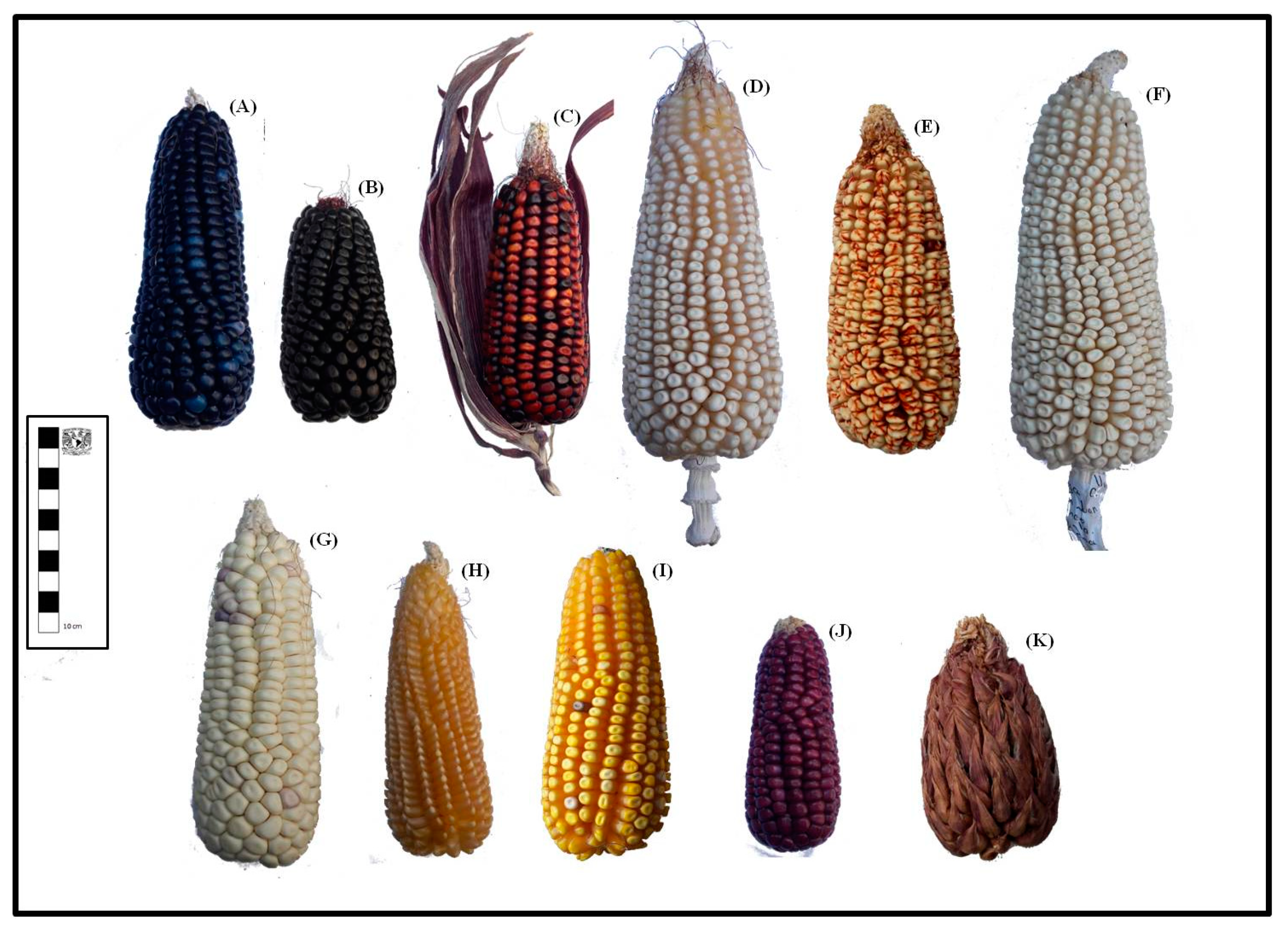
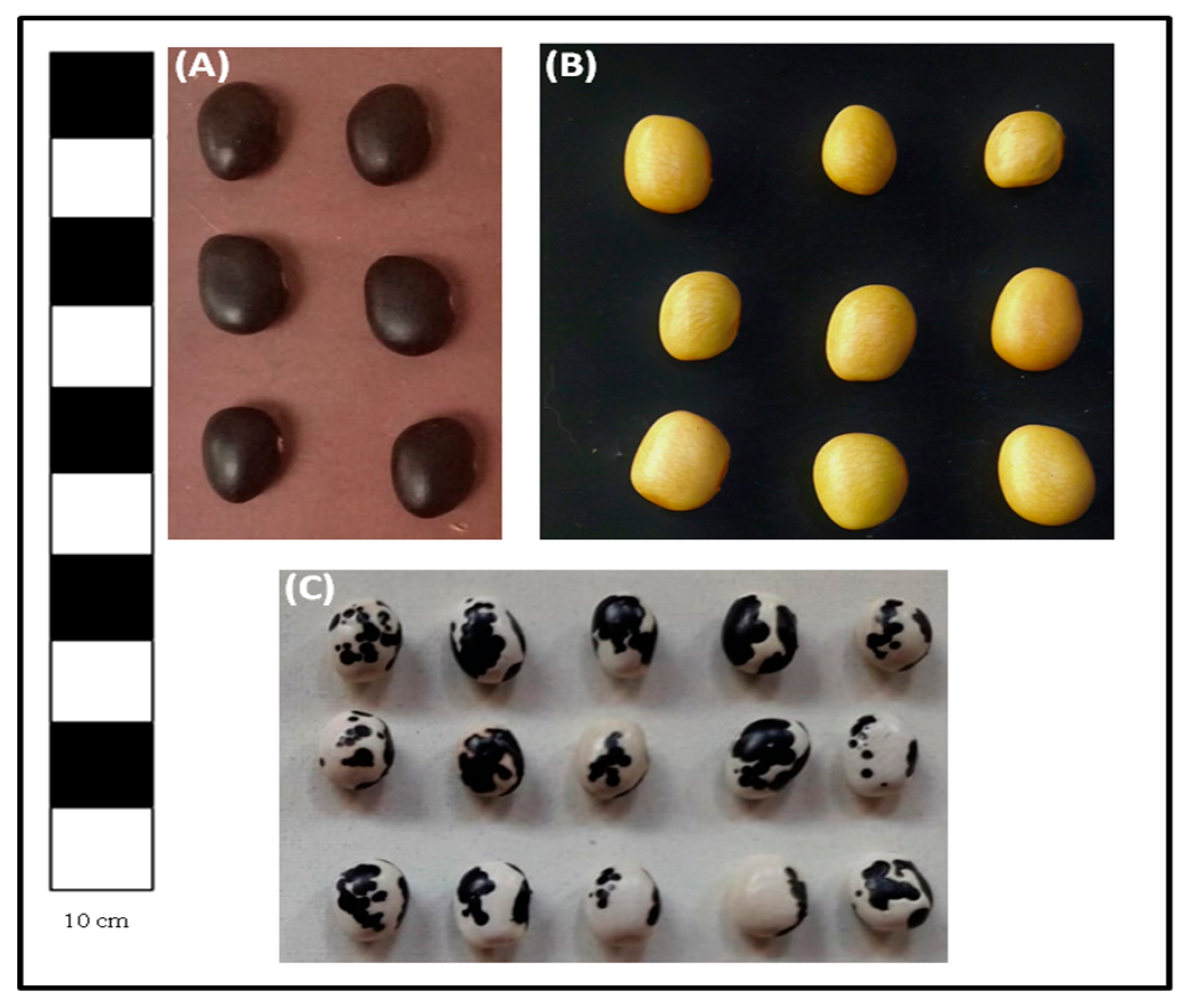
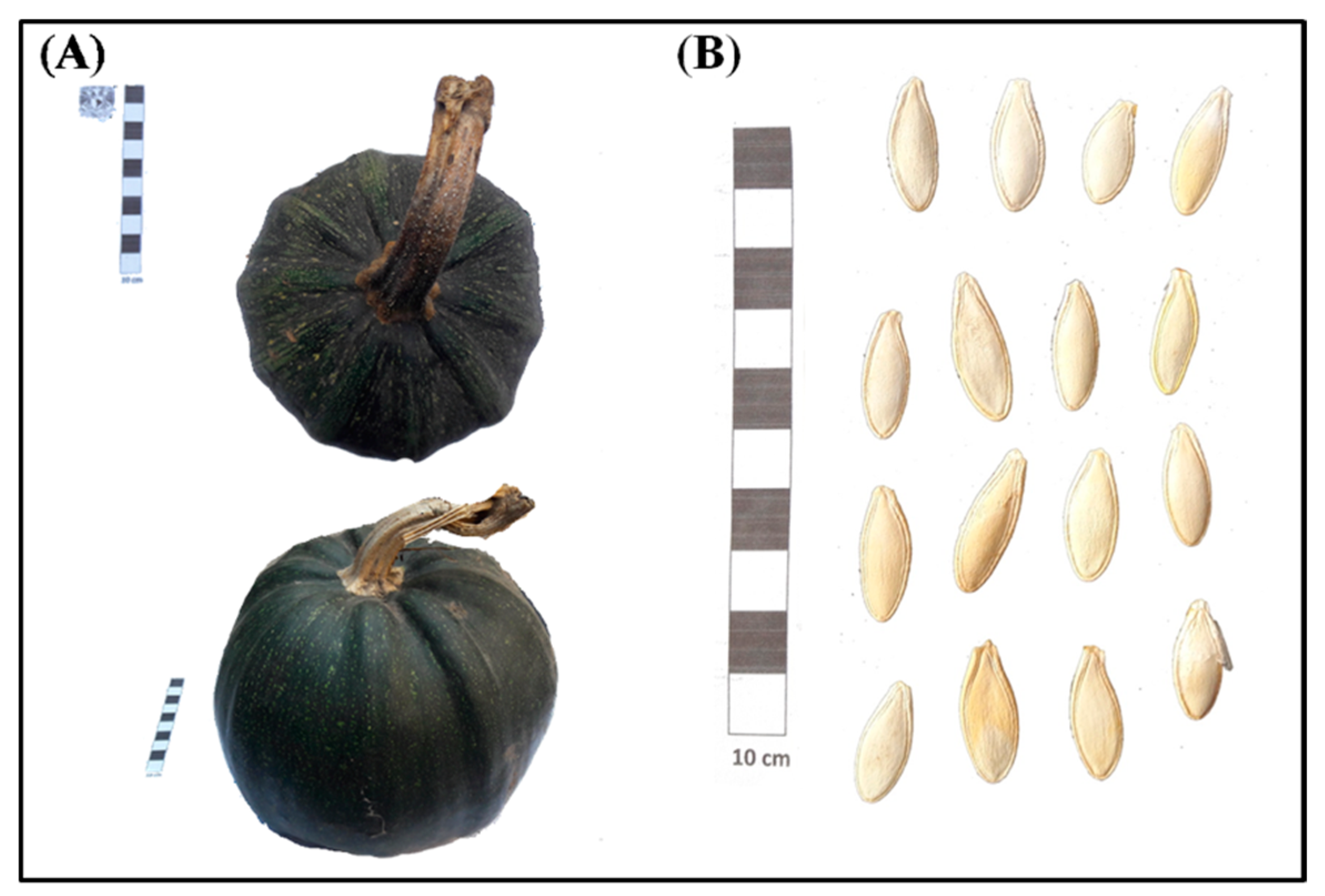
References
- Bellon, M.R. The dynamics of crop infraspecific diversity: A conceptual framework at the farmer level 1. Econ. Bot. 1996, 50, 26–39. [Google Scholar] [CrossRef]
- Boege, E. El Patrimonio Biocultural de Pueblos Indígenas de México. Hacia la Conservación In Sity de la Biodiversidad y Agrodiversidad en los Territorios Indígenas, 1st ed.; Instituto Nacional de Antropología e Historia, Comisión Nacional para el Desarrollo de los Pueblos Indígenas: Mexico City, Mexico, 2008; p. 344.
- Moreno-Calles, A.I.; Toledo, V.M.; Casas, A. Los sistemas agroforestales tradicionales de México: Una aproximación biocultural. Bot. Sci. 2013, 91, 375–398. [Google Scholar] [CrossRef]
- Almekinders, C.J.; Struik, P.C. The need to study and manage variation in agroecosystems. Neth. J. Agric. Sci. 1995, 43, 127–142. [Google Scholar]
- Brookfield, H.; Stocking, M. Agrodiversity: Definition, description and design. Glob. Environ. Change 1999, 5, 77–80. [Google Scholar] [CrossRef]
- Hodgkin, T.; Rana, R.; Tuxill, J.; Balma, D.; Subedi, A.; Mar, I.; Karamura, D.; Valdivia, R.; Collado, L.; Latournerie, L.; et al. Seed Systems and Crop Genetic Diversity in Agroecosistems. In Managing Biodiversity in Agricultural Ecosystems; Jarvis, D.I., Padoch, C., Cooper, H.D., Eds.; Bioversity Internacional: New York, NY, USA, 2007; Volume 492, pp. 77–116. [Google Scholar]
- Love, B. Agrobiodiversity: Its Value, Measurement, and Conservation in the Context of Sustainable Agriculture. J. Sustain. Agric. 2007, 31, 4–10. [Google Scholar] [CrossRef]
- Zizumbo-Villarreal, D.; Colunga-GarcíaMarín, P. Origin of agriculture and plant domestication in West Mesoamerica. Genet. Resour. Crop Evol. 2010, 57, 813–825. [Google Scholar] [CrossRef]
- Kato, T.A.; Mapes, C.; Mera, L.M.; Serratos, J.A.; Bye, R.A. Origen y Diversificación Del Maíz: Una Revisión Analítica, 1st ed.; CONABIO: Mexico City, Mexico, 2009; pp. 1–116.
- Fernández Suárez, R.; Morales Chávez, L.; Gálvez Marisca, A. Importance of mexican maize landraces in the national diet. An essential review. Rev. Fitotec. Mex. 2013, 36, 275–283. [Google Scholar]
- Gliessman, S.R. Agroecology: Ecological Processes in Sustainable Agriculture; Lewis Publishers: New York, NY, USA, 2000; pp. 3–24. [Google Scholar]
- Gliessman, S. Saving Seeds and Saving Culture. Agroecol. Sustain. Food Syst. 2015, 39, 599–600. [Google Scholar] [CrossRef]
- Thrupp, L.A. Linking agricultural biodiversity and food security: The valuable role of agrobiodiversity for sustainable agriculture. Int. Aff. 2000, 76, 265–281. Available online: http://www.jstor.org/stable/2626366 (accessed on 29 January 2022). [CrossRef]
- Louette, D.; Charrier, A.; Berthaud, J. In situ conservation of maize in Mexico: Genetic diversity and maize seed management in a traditional community. Econ. Bot. 1997, 51, 20–38. [Google Scholar] [CrossRef]
- Badstue, L.B.; Bellon, M.R.; Berthaud, J.; Juárez, X.; Rosas, I.M.; Solano, A.M.; Ramírez, A. Examining the Role of Collective Action in an Informal Seed System: A Case Study from the Central Valleys of Oaxaca, Mexico. Hum. Ecol. 2006, 34, 249–273. [Google Scholar] [CrossRef]
- Pautasso, M.; Aistara, G.; Barnaud, A.; Delêtre, M.; Demeulenaere, E.; De Santis, P.; Mckey, D.; Padoch, C.; Soler, C.; Thomas, M.; et al. Seed exchange networks for agrobiodiversity conservation. A review. A review. Agron. Sustain. Dev. 2013, 33, 151–175. [Google Scholar] [CrossRef] [Green Version]
- Requena, S.F. El concepto de red social. El concepto de red social. Rev. Española Investig. Sociológicas 1989, 48, 137–152. [Google Scholar]
- Barabási, A.L. Graph Theory. In Network Science, 1st ed.; Cambridge University Press: Glasgow, UK, 2016; pp. 43–69. [Google Scholar]
- Calvet-Mir, L.; Salpeteur, M. Humans, plants, and networks: A critical review. Environ. Soc. 2016, 7, 107–128. [Google Scholar] [CrossRef]
- Subedi, A.; Chaudhary, P.; Baniya, B.; Rana, R.; Tiwari, R.K.; Rijal, D.; Sthapit, B.; Jarvis, D. Who maintains genetic diversity and how? Policy implications tor agrobiodiversity management. Cult. Agric. 2003, 25, 41–50. [Google Scholar] [CrossRef]
- Abay, F.; de Boef, W.; Bjørnstad, Å. Network analysis of barley seed flows in Tigray, Ethiopia: Supporting the design of strategies that contribute to on-farm management of plant genetic resources. Plant Genet. Resour. 2011, 9, 495–505. [Google Scholar] [CrossRef]
- Poudel, D.; Sthapit, B.; Shrestha, P. An Analysis of Social Seed Network and Its Contribution to On-Farm Conservation of Crop Genetic Diversity in Nepal. Int. J. Biodivers. 2015, 2015, e312621. [Google Scholar] [CrossRef]
- Rodier, C.; Struik, P.C. Nodal Farmers’ Motivations for Exchanging Sorghum Seeds in Northwestern Ethiopia. Sustainability 2018, 10, 3708. [Google Scholar] [CrossRef] [Green Version]
- Calvet-Mir, L.; Calvet-Mir, M.; Molina, J.L.; Reyes-García, V. Seed Exchange as an Agrobiodiversity Conservation Mechanism. A Case Study in Vall Fosca, Catalan Pyrenees, Iberian Peninsula. Ecol. Soc. 2012, 17, 29. [Google Scholar] [CrossRef] [Green Version]
- Devkota, R.; Khadka, K.; Gartaula, H.; Shrestha, A.; Upadhya, D.; Chaudhary, P.; Patel, K. Farmers’ seed networks and agro biodiversity conservation for sustainable food security: A case from the mid-hills of Nepal. Biodivers. Watch 2014, 4, 109–133. [Google Scholar]
- Subedi, A.; Singh, D.; Shrestha, P.; Subedi, S.R.; Sthapit, B.R. Stability of farmers’ networks and nodal farmers in terai and hill villages of Nepal: Implications for agrobiodiversity management on-farm. In On-Farm Conservation of Agricultural Biodiversity in Nepal: Volume II. Managing Diversity and Promoting Its Benefits, Proceedings of the Second National Workshop, Nagarkot, Nepal, 25–27 August 2004; Sthapit, B.R., Upadhyay, M.P., Shrestha, P.K., Jarvis, D.I., Eds.; International Plant Genetic Resources Institute: Rome, Italy, 2005; Volume 2, pp. 36–40. [Google Scholar]
- Song, Y.; Fang, Q.; Jarvis, D.; Bai, K.; Liu, D.; Feng, J.; Long, C. Network analysis of seed flow, a traditional method for conserving Tartary buckwheat (Fagopyrum tataricum) landraces in Liangshan, Southwest China. Sustainability 2019, 11, 4263. [Google Scholar] [CrossRef] [Green Version]
- Poudel, D.; Shrestha, P.; Basnet, A.; Shrestha, P.; Sthapit, B.; Subedi, A. Stability of farmers’ networks and nodal farmers in rice seed flow system: Does it matter for on-farm conservation? In On-Farm Management of Agricultural Biodiversity in Nepal: Lessons learned, Proceedings of National Symposium, Kathmandu, Nepal, 18–19 July 2006; Sthapit, B., Gauchan, D., Eds.; LI-BIRD: Pokhara, Nepal; Bioversity International: Rome, Italy; Nepal Agriculture Research Council: Kathmandu, Nepal, 2006; pp. 99–108. [Google Scholar]
- Baniya, B.; Subedi, A.; Rana, R.; Tiwari, R.K.; Chaudhary, P.; Shrestha, S.; Tiwari, P.; Yadav, R.; Gauchan, D.; Sthapit, B. What are the processes used to maintain genetic diversity on-farm. In Agrobiodiversity Conservation On-farm: Nepal’s Contribution to a Scientific Basis for National Policy Recommendations; Gauchan, D., Sthapit, B.R., Jarvis, D., Eds.; IPGRI: Rome, Italy, 2003; pp. 20–23. [Google Scholar]
- Sustainable Development Goals. Available online: https://www.un.org/sustainabledevelopment/hunger/ (accessed on 17 March 2022).
- FAO. The Future of Food and Agriculture: Alternative Pathways to 2050; FAO: Rome, Italy, 2018; p. 8. Available online: https://www.fao.org/publications/fofa/en/ (accessed on 29 January 2022).
- FAO; IFAD. Decenio de las Naciones Unidas Para la Agricultura Familiar 2019–2028. Plan de Acción Mundial; FAO: Rome, Italy, 2019; p. 8. [Google Scholar]
- FAO. El Estado Mundial de la Agricultura y la Alimentación. La Innovación en la Agricultura Familiar; FAO: Rome, Italy, 2014; p. 11. [Google Scholar]
- Lipper, L.; Anderson, C.L.; Dalton, T.J. Seed Trade in Rural Markets Implications for Crop Diversity and Agricultural Development, 1st ed.; The Food and Agriculture Organization of the United Nations and Earthscan: Gateshead, UK; London, UK, 2010; pp. 1–232. [Google Scholar]
- CONABIO (Comisión Nacional Para el Conocimiento y Uso de la Biodiversidad). Razas de Maíz de Mexico. Available online: https://www.biodiversidad.gob.mx/diversidad/alimentos/maices/razas/grupo-conico (accessed on 5 March 2021).
- Espinosa-Pérez, E.N.; Ramírez-Vallejo, P.; Crosby-Galván, M.M.; Estrada-Gómez, J.A.; Chávez-Servia, B.L.J.L. Classification of common dry bean landraces from the south-center of méxico by seed morphology. Rev. Fitotec. Mex. 2015, 29, 29–38. [Google Scholar]
- Lira, R.; Rodriguez-Jimenez, C.; Alvarado, J.L.; Rodriguez, I.; Castrejon, J.; Dominguez-Marian, A. Diversidad e importancia de la familia Cucurbitaceae en México. Acta Botánica Mex. 1998, 42, 43–77. [Google Scholar] [CrossRef]
- Eguiarte, L.E.; Hernández-Rosales, H.S.; Barrera-Redondo, J.; Castellanos-Morales, G.; Paredes-Torres, L.M.; Sánchez-de la Vega, G.; Lira, R. Domesticación, diversidad y recursos genéticos y genómicos de México: El caso de las calabazas. TIP Rev. Espec. Cienc. Químico-Biológicas 2018, 21, 85–101. [Google Scholar] [CrossRef]
- Lazos Chavero, E. Consideraciones socioeconómicas y culturales en la controvertida introducción del maíz transgénico: El caso de Tlaxcala. Sociológica 2014, 29, 201–240. [Google Scholar]
- Lazos, C.E.; Chauvet, M. Análisis del Contexto Social y Biocultural de las Colectas de Maíces Nativos en México; Proyecto Global de Maíces, Informe de Gestión, CONABIO: Mexico City, Mexico, 2011. [Google Scholar]
- INEGI Banco de Indicadores Ixtenco, Tlaxcala. Available online: https://www.inegi.org.mx/app/indicadores/?ag=29016 (accessed on 5 March 2021).
- Sánchez-Morales, P.; Ocampo-Fletes, I.; Parra-Inzunza, F.; Sánchez-Escudero, J.; María-Ramírez, A.; Argumedo-Macías, A. Evaluación de la sustentabilidad del agroecosistema maíz en la región de Huamantla, Tlaxcala, México. Agroecología 2014, 9, 111–122. [Google Scholar]
- RAN (Registro Agrario Nacional). Available online: https://www.gob.mx/ran (accessed on 22 March 2021).
- Llanos Hernández, L.; de León, E.E.S. Food sovereignty and environmental risk in the social construction of rural territory in San Juan Ixtenco, Tlaxcala. Textual 2018, 72, 161. [Google Scholar] [CrossRef]
- SIAP (Servicio de Información Agroalimentaria y Pesquera). Avance de Siembras y Cosechas Resumen por Estado: Tlaxcala. Available online: https://nube.siap.gob.mx/cierreagricola/ (accessed on 8 May 2021).
- Goodman, L.A. Snowball sampling. Ann. Math. Stat. 1961, 32, 148–170. [Google Scholar] [CrossRef]
- Biernacki, P.; Waldorf, D. Snowball sampling: Problems and techniques of chain referral sampling. Sociol. Methods Res. 1981, 10, 141–163. [Google Scholar] [CrossRef]
- Hernández-Rojas, C.; (Coordinador de la Fiesta del Maíz, Productores de Ixtenco, Ixtenco, Tlaxcala, Mexico). Personal Communication, 2019.
- Baez, G.R.A.; (Comisariado Ejidal del Municipio de Huamantla, Produtores de Huamantla, Huamantla, Tlaxcala, Mexico). Personal Communication, 2019.
- Shannon, P.; Markiel, A.; Ozier, O.; Baliga, N.S.; Wang, J.T.; Ramage, D.; Amin, N.; Schwikowski, B.; Ideker, T. Cytoscape: A Software Environment for Integrated Models of Biomolecular Interaction Networks. Genome Res. 2003, 13, 2498–2504. [Google Scholar] [CrossRef]
- Kohl, M.; Wiese, S.; Warscheid, B. Cytoscape: Software for visualization and analysis of biological networks. In Data Mining in Proteomics from Standards to Applications, Methods in Molecular Biology; Hamacher, M., Eisenacher, M., Stephan, C., Eds.; Humana Press: Totowa, NJ, USA, 2011; Volume 696, pp. 291–303. [Google Scholar] [CrossRef]
- Bellon, M.R. Conceptualizing interventions to support on-farm genetic resource conservation. World Dev. 2004, 32, 159–172. [Google Scholar] [CrossRef]
- Badstue, L.B. Identifying the Factors that Influence Small-Scale Farmers’ Transaction Costs in Relation to Seed Acquisition. An Ethnographic Case Study of Maize Growing Smallholders in the Central Valleys of Oaxaca, Mexico, FAO; ESA: Rome, Italy, 2004; pp. 1–43. [Google Scholar]
- van Niekerk, J.; Wynberg, R. Traditional seed and exchange systems cement social relations and provide a safety net: A case study from KwaZulu-Natal, South Africa. Agroecol. Sustain. Food Syst. 2017, 41, 1099–1123. [Google Scholar] [CrossRef]
- Vernooy, R.; Sthapit, B.; Galluzzi, G.; Shrestha, P. The Multiple Functions and Services of Community Seedbanks. Resources 2014, 3, 636–656. [Google Scholar] [CrossRef]
- Vernooy, R.; Shrestha, P.; Sthapit, B. Community Seed Banks: Origins, Evolution and Prospects, 1st ed.; Routledge: New York, NY, USA, 2015; pp. 1–270. [Google Scholar]
- Mendoza-Mendoza, C.G.; Castillo, M.D.C.M.; González, F.C.; Ramírez, F.J.S.; Alvarado, A.D.; Pecina-Martínez, J.A. Agronomic Performance and Grain Yield of Mexican Purple Corn Populations from Ixtenco. Maydica 2019, 64, 9. [Google Scholar]
- Shagarodsky, T.; Arias, L.; Castiñeiras, L.; García, M.; Giraudy, C. Ferias de agrobiodiversidad y semillas como apoyo a la conservación de la biodiversidad en Cuba y Mexico. In Cómo Conservan los Agricultores Sus Semillas en el Trópico Húmedo de Cuba, Mexico y Perú; Hermann, M., Amaya, K., Latournerie, L., Castiñeiras, L., Eds.; Bioversity International: Roma, Italy, 2009; pp. 101–122. [Google Scholar]
- Cababé, J.; Bonicatto, M.M.; Abbona, E. Semillas y saberes de los agricultores familiares. ¿Cuál es el rol de las ferias de intercambio en su reproducción y conservación? Rev. Fac. Agron. 2015, 114, 122–128. [Google Scholar]
- Leyte, J.D.; Delaquis, E.; Van Dung, P.; Douxchamps, S. Linking Up: The Role of Institutions and Farmers in Forage Seed Exchange Networks of Southeast Asia. Hum. Ecol. 2021, 50, 61–78. [Google Scholar] [CrossRef]
- Violon, C.; Thomas, M.; Garine, E. Good year, bad year: Changing strategies, changing networks? A two-year study on seed acquisition in northern Cameroon. Ecol. Soc. 2016, 21, 34. [Google Scholar] [CrossRef] [Green Version]
- Otieno, G.; Zebrowski, W.M.; Recha, J.; Reynolds, T.W. Gender and Social Seed Networks for Climate Change Adaptation: Evidence from Bean, Finger Millet, and Sorghum Seed Systems in East Africa. Sustainability 2021, 13, 2074. [Google Scholar] [CrossRef]
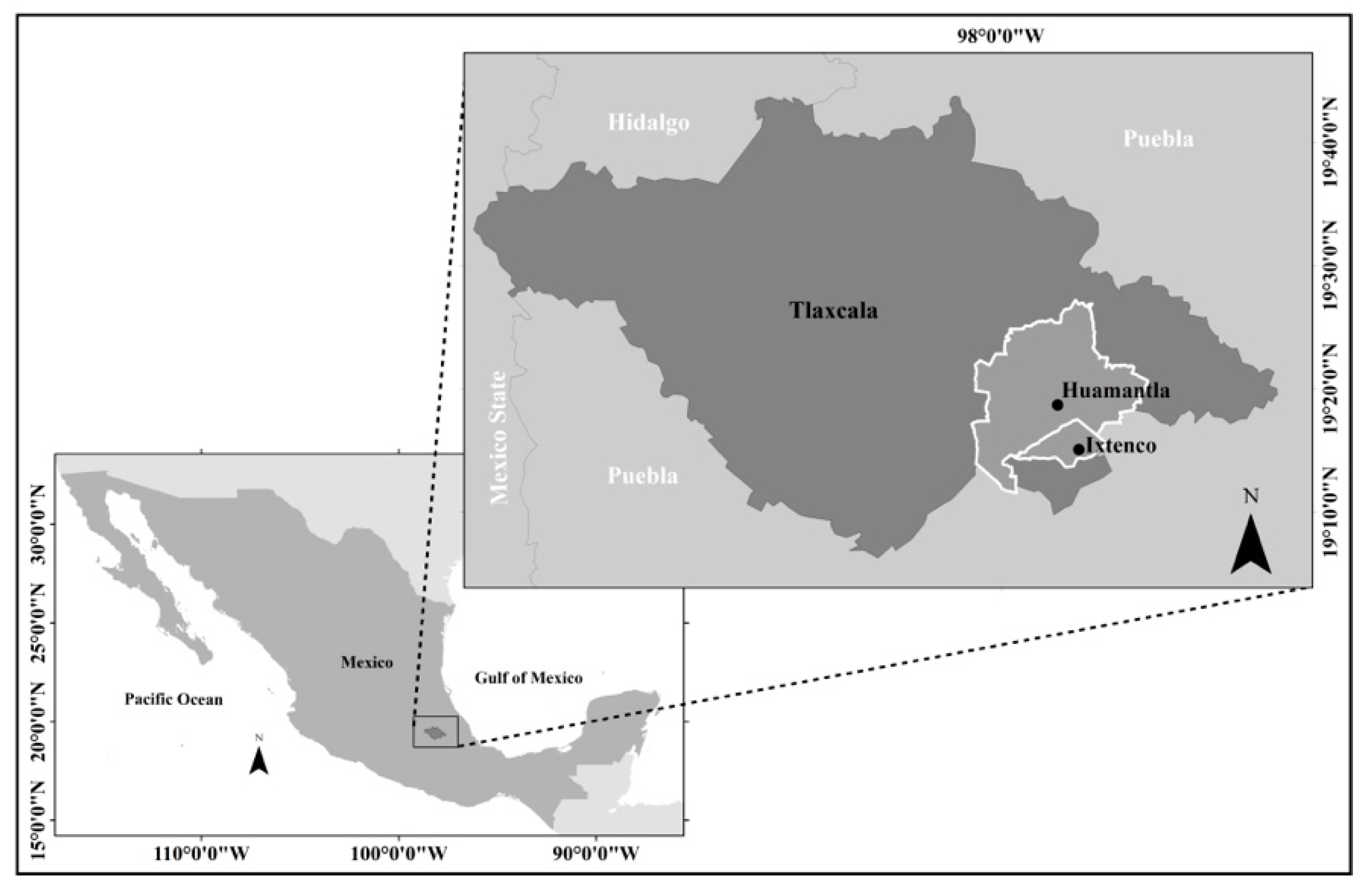
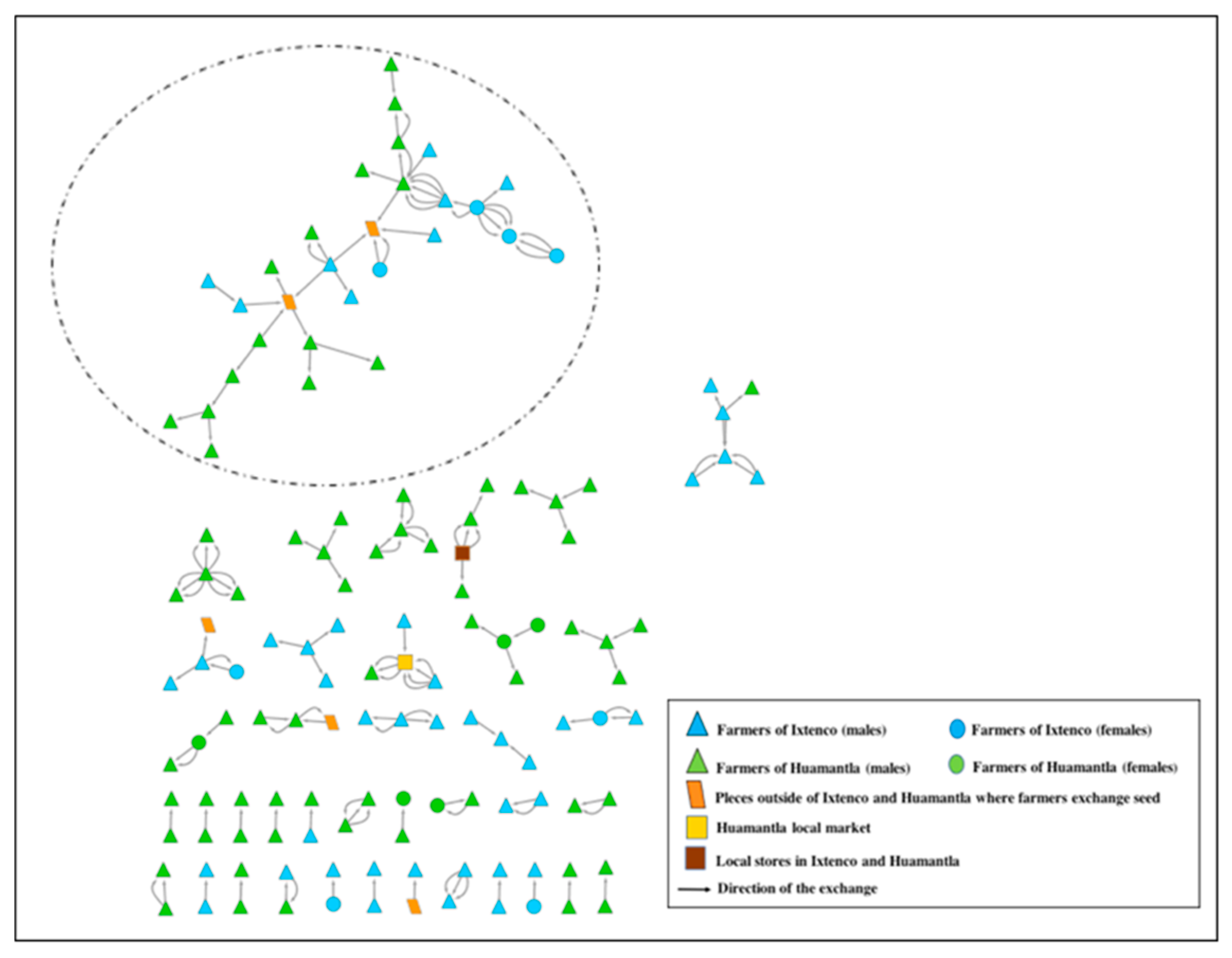
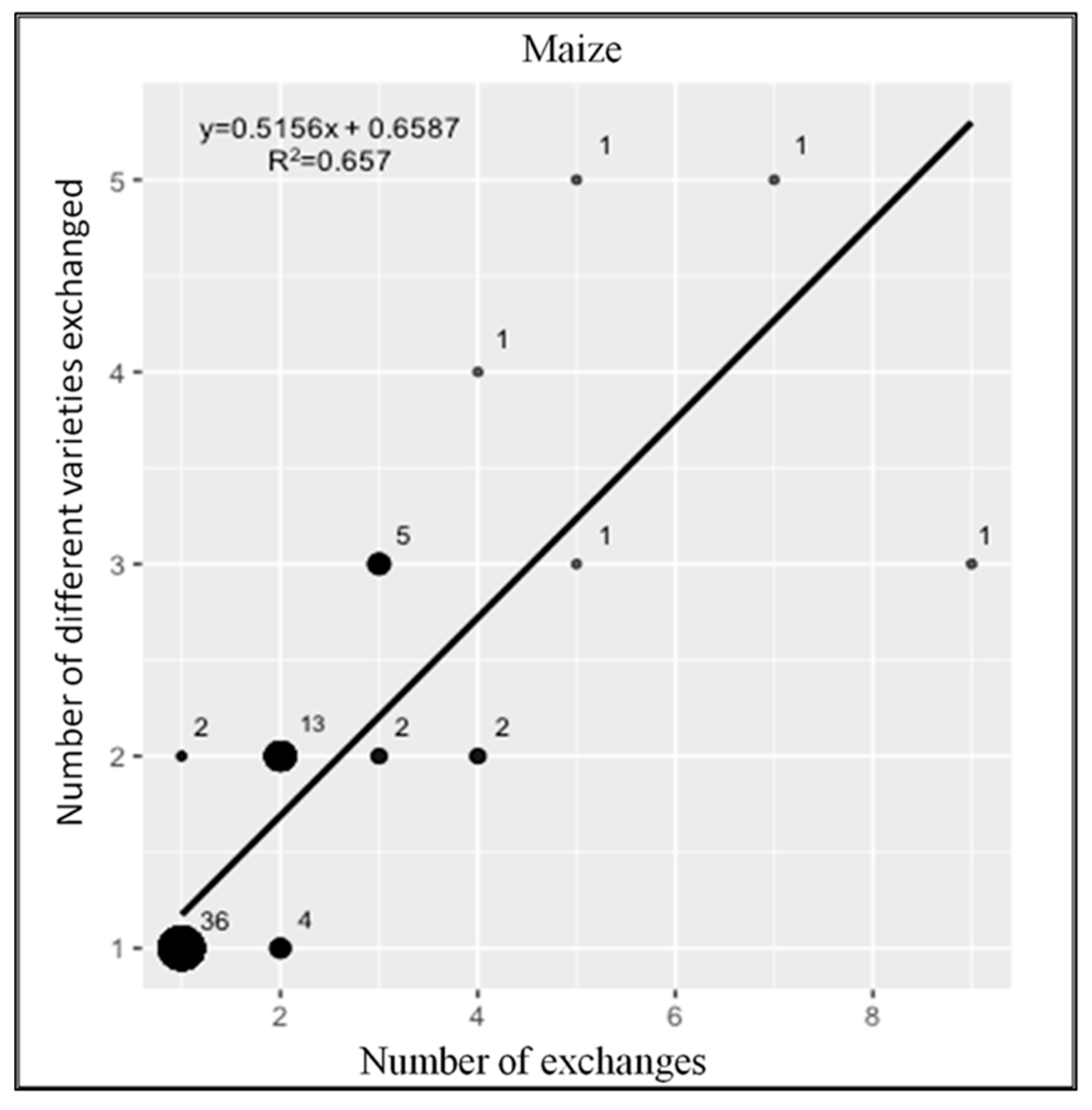
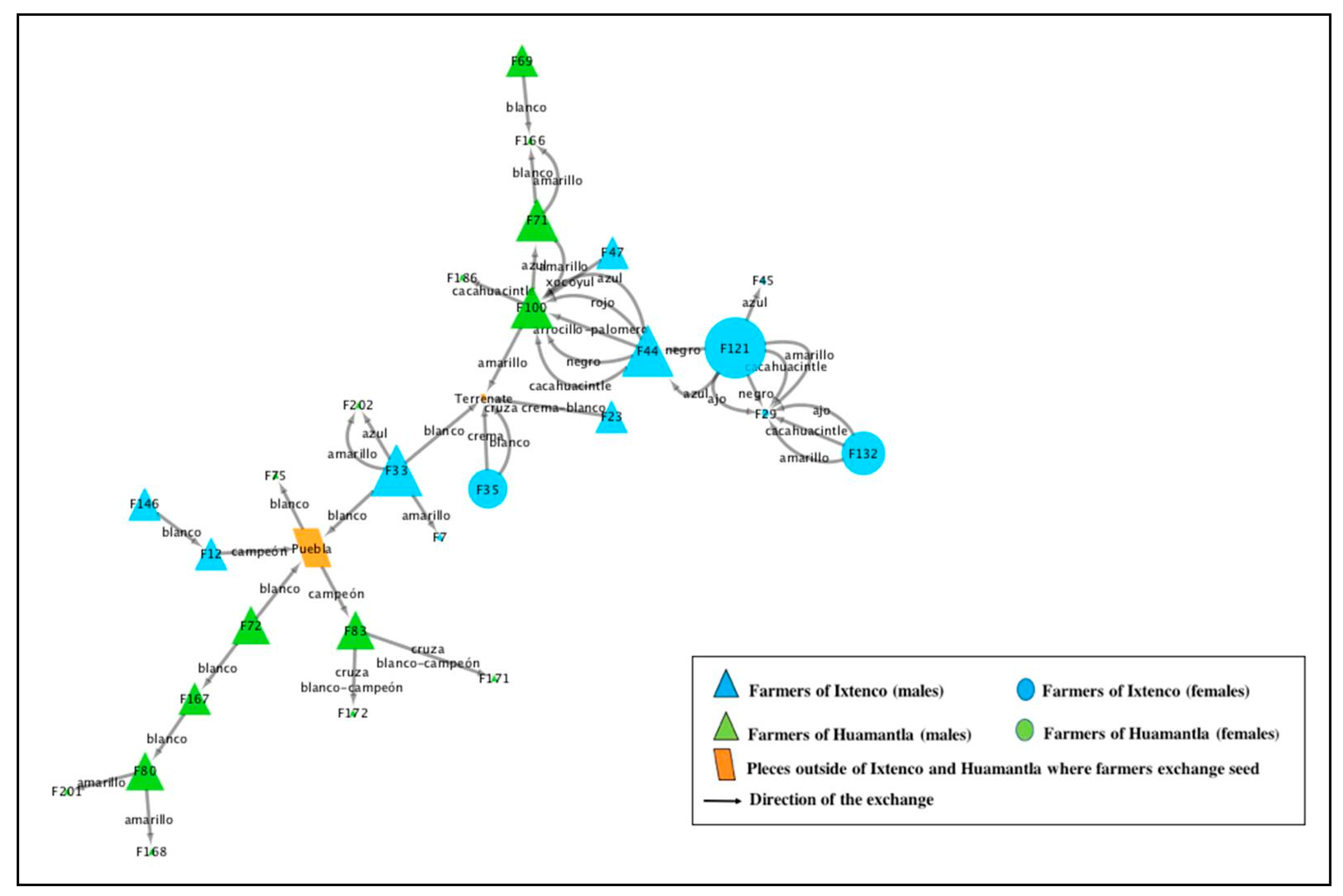
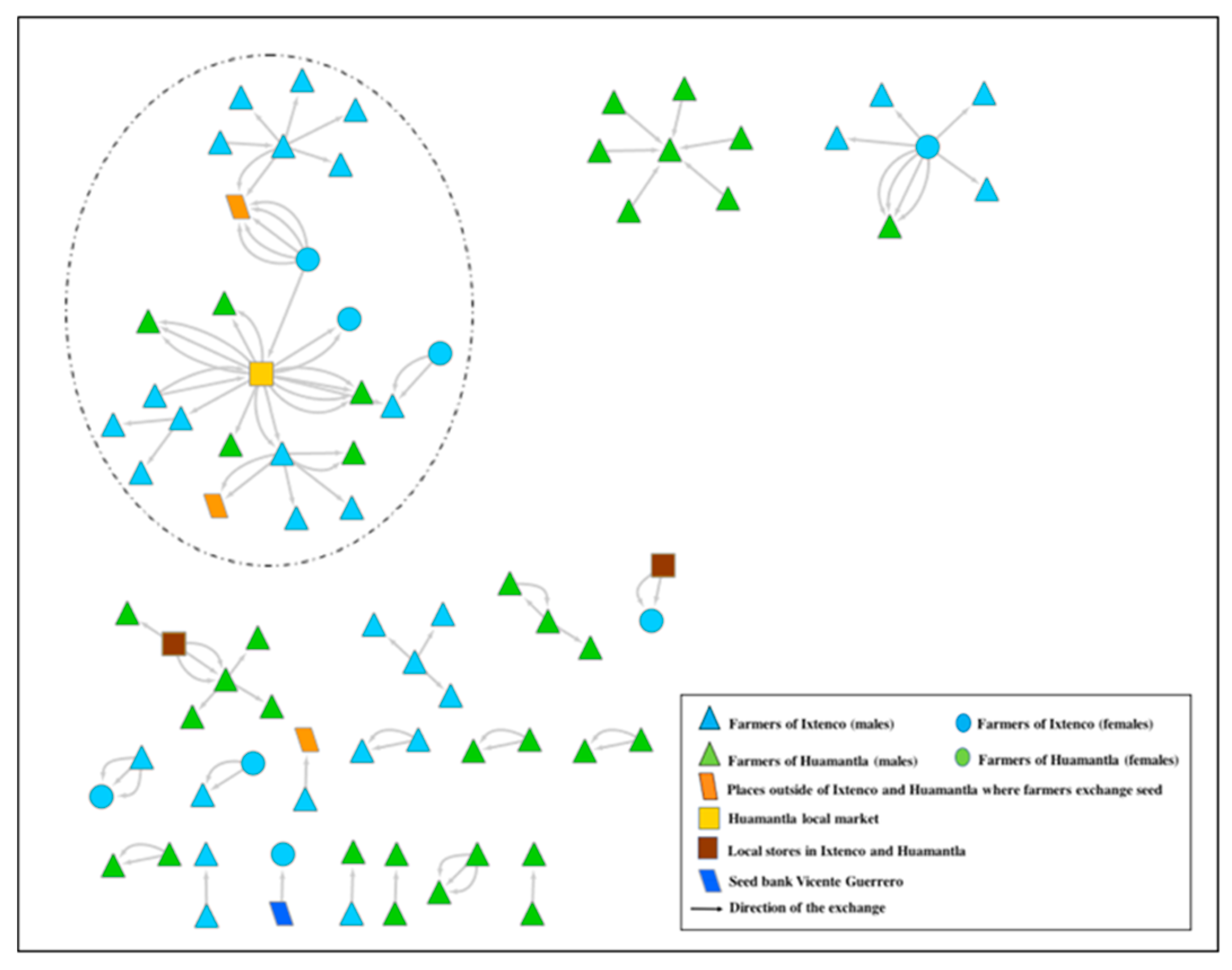
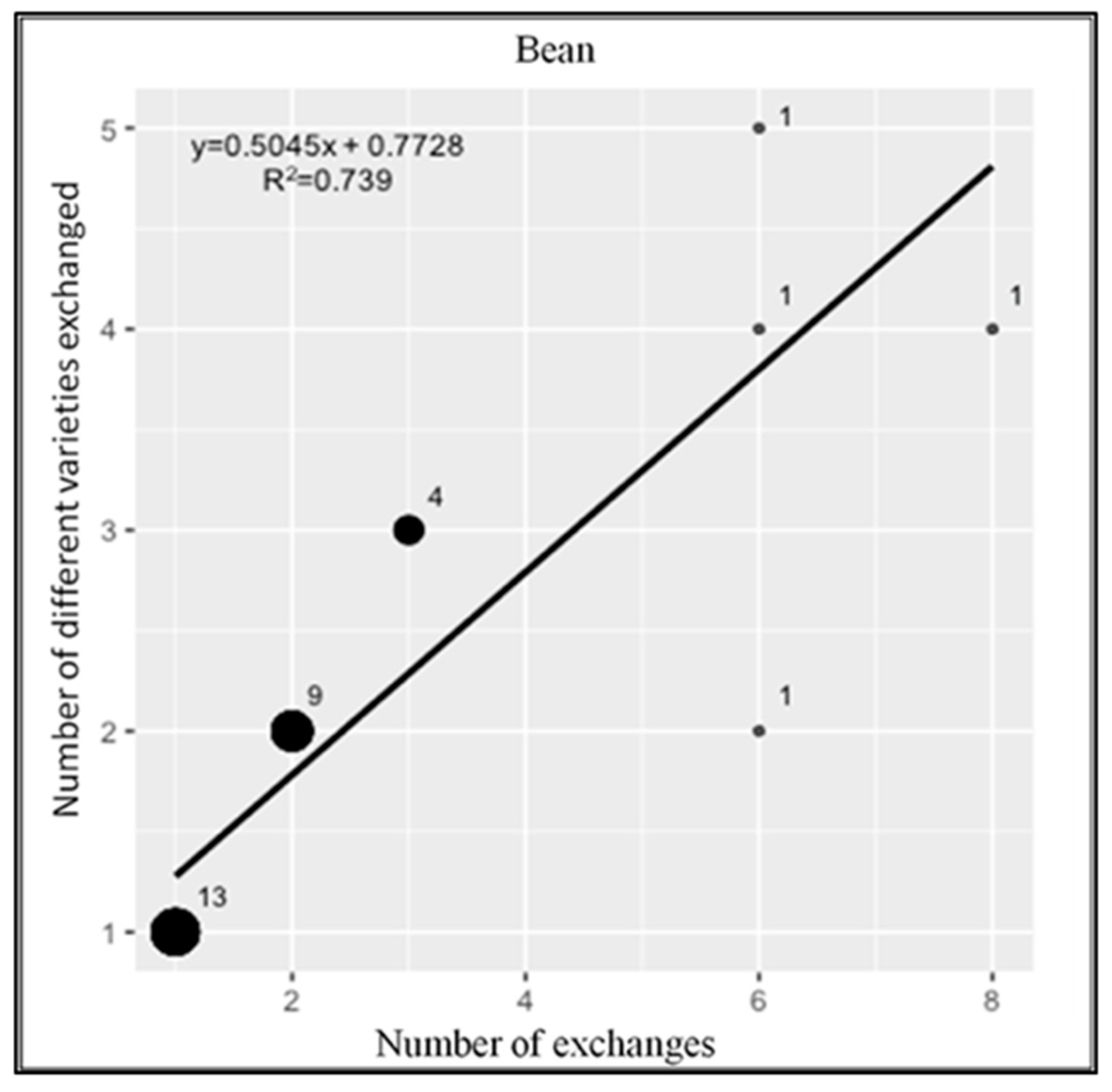
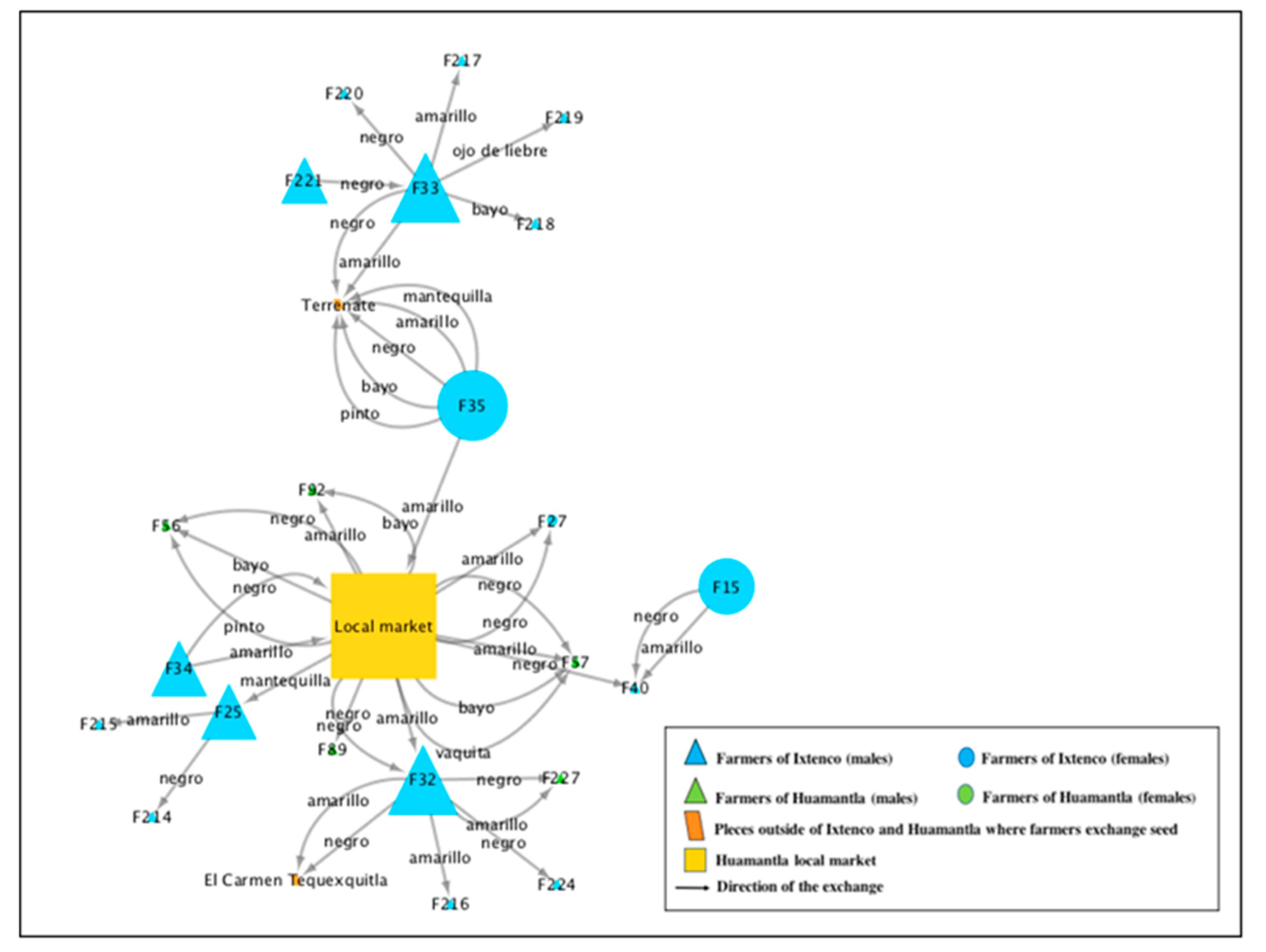
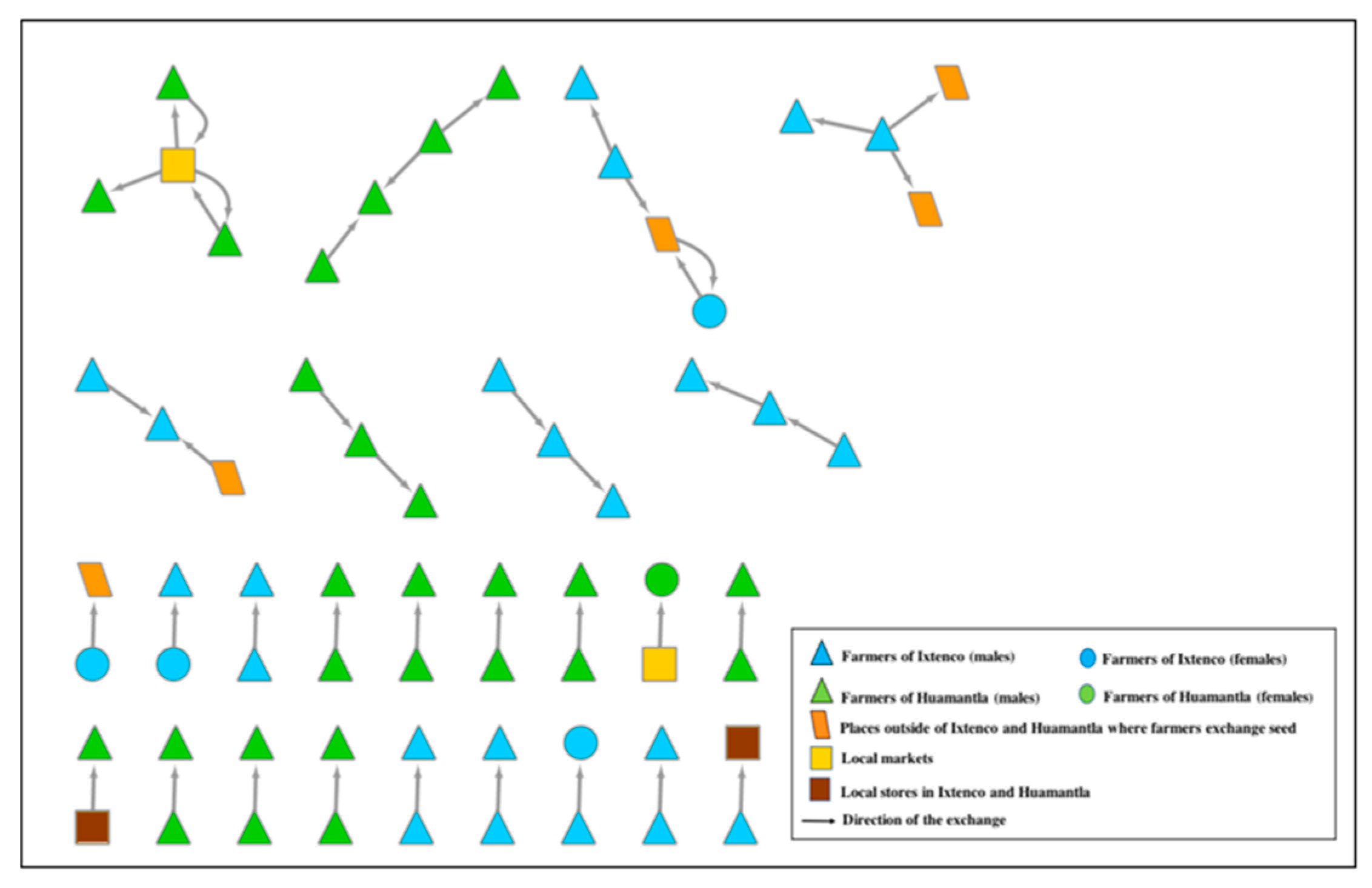
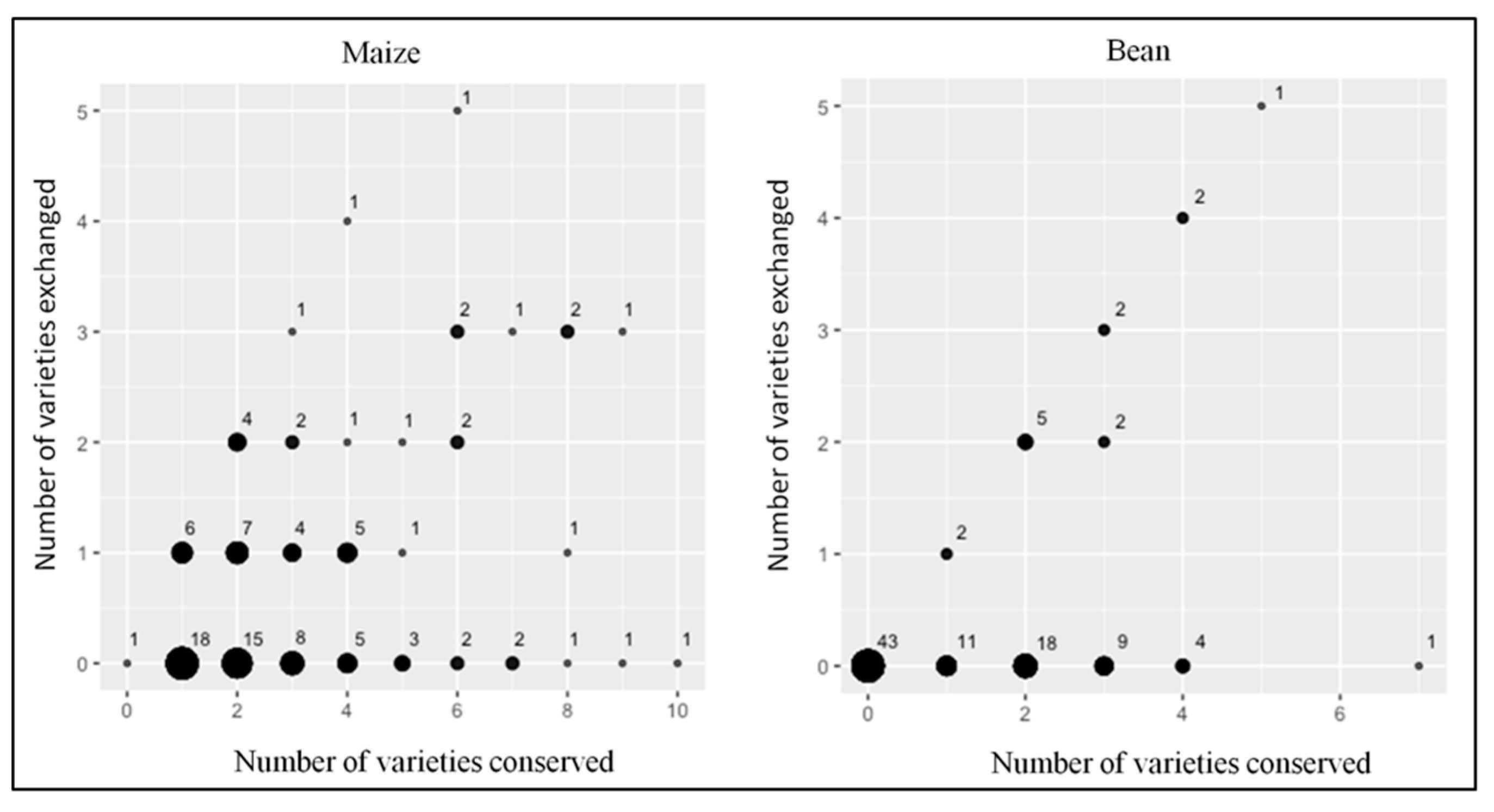
| Variety | Number of Farmers Who Conserve the Variety in Ixtenco (n = 50) | Number of Farmers Who Conserve the Variety in Huamantla (n = 50) | Benefits and Importance of the Variety to Farmers |
|---|---|---|---|
| Maize varieties | |||
| Blanco | 42 (84%) | 40 (80%) | The grain has a high market demand. Used for tortillas and flour. Appreciated for the weight, size, and color of cobs. |
| Amarillo | 17 (34%) | 26 (52%) | Principally for animal consumption. Appreciated for color and weight of cobs. |
| Azul | 32 (64%) | 25 (50%) | Appreciated for color and appearance of cobs. Due to increased demand in recent years, it is sold at a higher price than other varieties. |
| Crema | 13 (26%) | 4 (8%) | Appreciated for the weight of cobs. |
| Negro | 22 (44%) | 7 (14%) | Highly appreciated by farmers of Ixtenco. Used to make the traditional cooked fermented corn drink “atole agrio”. |
| Cacahuacintle | 23 (46%) | 3 (6%) | Used for making traditional Mexican food such as pozole, and maize flour. |
| Ocho carreras | - | 3 (6%) | Appreciated for size and weight of cobs. |
| Xocoyul | 14 (28%) | 2 (4%) | Its flour is used for preparing the beverage atole, appreciated for its pink color. |
| Campeón | 1 (2%) | 2 (4%) | Appreciated for the large size and weight of cobs. |
| Ajo o tunicado | 5 (10%) | - | High cultural value in Ixtenco due to cob characteristics. |
| Chalqueño | - | 3 (6%) | Appreciated for color and size of kernel. |
| Rojo | 18 (36%) | 1 (2%) | Used to make maize flour. |
| Cruza blanco-campeón | - | 1 (2%) | Appreciated for color and the cobs. |
| Sangre de cristo | 10 (20%) | - | Its flour is used for atole and the kernels for handcrafts. |
| Arrocillo-palomero | 2 (4%) | 1 (2%) | Marketed and used for family consumption. |
| Ancho | - | 1 (2%) | Appreciated for short agricultural cycle. |
| Bean varieties | |||
| Amarillo | 23 (46%) | 22 (44%) | It is marketed and used for family consumption. |
| Negro | 25 (50%) | 11 (22%) | It cooks rapidly and is marketed and used for family consumption. |
| Bayo | 14 (28%) | 18 (36%) | It is marketed and used for family consumption. |
| Mantequilla | 3 (6%) | 2 (4%) | It is marketed and used for family consumption. |
| Parraleño | 3 (6%) | - | It is marketed and used for family consumption. |
| Pinto | 3 (6%) | 3 (6%) | It is marketed and used for family consumption. |
| Ojo de liebre | 1 (2%) | 2 (4%) | It is marketed and used for family consumption. |
| Vaquita | - | 3 (6%) | It is marketed and used for family consumption. |
| Morado | - | 1 (2%) | It is marketed and used for family consumption. |
| Flor de mayo | - | 1 (2%) | It is marketed and used for family consumption. |
| Squash variety | |||
| Squash | 41 (82%) | 36 (72%) | It is appreciated by farmers for the size of the seeds, its color, and its productivity. |
| Other crops | |||
| * | 21 (42%) | 21 (42%) | These crops are for market and used for family consumption. |
| Maize Variety | Total Exchanges per Variety (Fa + Fr + N + A + Nk) | Number of Farmers Who Exchanged the Variety | Locality | Number of Exchanges per Variety | Number of Farmers Who Exchanged the Variety | Number of Exchanges among Actors in the Maize Network | |||||
|---|---|---|---|---|---|---|---|---|---|---|---|
| Family Members (Fa) | Friends (Fr) | Neighbors (N) | Acquaintan (A) | Does Not Know the Person (Nk) | Total Exchanges Outside the Location | ||||||
| Blanco | 52 | 36 | I | 19 | 14 | 2 (10.53%) | 4 (21.05%) | 2 (10.53%) | 10 (52.63%) | 1 (5.26%) | 3 |
| H | 33 | 22 | 5 (15.15%) | - | 5 (15.15%) | 21 (63.64%) | 2 (6.06%) | 2 | |||
| Amarillo | 26 | 18 | I | 11 | 9 | 5 (45.45%) | 2 (18.18%) | - | 3 (27.27%) | 1 (9.09%) | - |
| H | 15 | 9 | 2 (13.33%) | 1 (6.67%) | 1 (6.67%) | 10 (66.67%) | 1 (6.67%) | 1 | |||
| Azul | 22 | 17 | I | 10 | 8 | 1 (10%) | 3 (30%) | - | 5 (50%) | 1 (10%) | - |
| H | 12 | 9 | 3 (25%) | 1 (8.33%) | 1 (8.33%) | 5 (41.67%) | 2 (16.67%) | 1 | |||
| Crema | 7 | 7 | I | 5 | 3 | 1 (20%) | 1 (20%) | - | 3 (60%) | - | 1 |
| H | 2 | 2 | - | - | - | 1 (50%) | 1 (50%) | 1 | |||
| Negro | 7 | 5 | I | 3 | 3 | 1 (33.33%) | 1 (33.33%) | - | - | 1 (33.33%) | - |
| H | 4 | 2 | - | 1 (25%) | - | 3 (75%) | - | - | |||
| Cacahuacintle | 5 | 3 | I | 3 | 2 | 2 (66.67%) | 1 (33.33%) | - | - | - | - |
| H | 2 | 1 | - | 1 (50%) | - | 1 (50%) | - | - | |||
| Ocho carreras | 4 | 2 | I | - | - | - | - | - | - | - | - |
| H | 4 | 2 | - | - | 2 (50%) | 2 (50%) | - | - | |||
| Xocoyul | 3 | 3 | I | 2 | 2 | - | 1 (50%) | - | 1 (50%) | - | - |
| H | 1 | 1 | - | - | - | 1 (100%) | - | - | |||
| Campeón | 3 | 3 | I | 1 | 1 | 1 (100%) | - | - | - | - | 1 |
| H | 2 | 2 | 1 (50%) | - | - | 1 (50%) | - | 1 | |||
| Ajo o tunicado | 3 | 2 | I | 3 | 2 | 2 (66.67%) | - | - | 1 (33.33%) | - | 1 |
| H | - | - | - | - | - | - | - | - | |||
| Chalqueño | 2 | 2 | I | - | - | - | - | - | - | - | - |
| H | 2 | 2 | - | - | - | 1 (50%) | 1 (50%) | - | |||
| Rojo | 2 | 2 | I | 1 | 1 | - | - | - | 1 (100%) | - | - |
| H | 1 | 1 | - | 1 (100%) | - | - | - | - | |||
| Cruza crema-blanco | 2 | 2 | I | 2 | 2 | - | 1 (50%) | - | - | 1 (50%) | 1 |
| H | - | - | - | - | - | - | - | - | |||
| Cruza blanco-campeón | 2 | 1 | I | - | - | - | - | - | - | - | - |
| H | 2 | 1 | - | - | 1 (50%) | 1 (50%) | - | - | |||
| Sangre de cristo | 1 | 1 | I | 1 | 1 | - | - | - | 1 (100%) | - | - |
| H | - | - | - | - | - | - | - | - | |||
| Arrocillo- palomero | 1 | 1 | I | 1 | 1 | - | 1 (100%) | - | - | - | - |
| H | - | - | - | - | - | - | - | - | |||
| Amealco | 1 | 1 | I | 1 | 1 | - | - | - | - | 1 (100%) | 1 |
| H | - | - | - | - | - | - | - | - | |||
| Ancho | 1 | 1 | I | 1 | 1 | - | - | - | 1 (100%) | - | - |
| H | - | - | - | - | - | - | - | - | |||
| Total Ixtenco | I | 64 | 51 | 15 | 15 | 2 | 26 | 6 | 8 | ||
| Total Huamantla | H | 80 | 54 | 11 | 5 | 10 | 47 | 7 | 6 | ||
| Total | I-H | 144 | 105 | 26 | 20 | 12 | 73 | 13 | 14 | ||
| Node | Location of Farmer/Site Where the Seed Is from | Nodal (N) or Connector Farmer (C) | Outdegree | Indegree | Number of Different Varieties Exchanged | Betweenness Centrality | Closeness Centrality |
|---|---|---|---|---|---|---|---|
| F84 | Huamantla | N | 9 | 0 | 3 | 0 | 1 |
| F121 | Ixtenco | N | 7 | 0 | 5 | 0 | 0.444 |
| F33 | Ixtenco | N | 5 | 0 | 3 | 0 | 0.571 |
| F44 | Ixtenco | N | 5 | 2 | 5 | 0.006 | 0.5 |
| F11 | Ixtenco | 4 | 0 | 2 | 0 | 1 | |
| F21 | Ixtenco | 4 | 0 | 2 | 0 | 1 | |
| F34 | Ixtenco | N | 4 | 0 | 4 | 0 | 0.666 |
| Agrochemical store | Agrochemical store | 4 | 0 | 4 | 0 | 0.75 | |
| F5 | Ixtenco | 3 | 1 | 3 | 0.333 | 1 | |
| F132 | Ixtenco | 3 | 0 | 3 | 0 | 1 | |
| F32 | Ixtenco | 3 | 0 | 3 | 0 | 1 | |
| Huamantla local market | Huamantla local market | 3 | 5 | 3 | 0.333 | 1 | |
| F41 | Ixtenco | 3 | 0 | 3 | 0 | 1 | |
| F71 | Huamantla | 3 | 1 | 2 | 0.005 | 0.666 | |
| F100 | Huamantla | 3 | 7 | 3 | 0.0185 | 0.8 | |
| F85 | Huamantla | 3 | 0 | 2 | 0 | 1 | |
| F1 | Ixtenco | 2 | 0 | 2 | 0 | 1 | |
| F30 | Ixtenco | C | 2 | 1 | 1 | 0.5 | 1 |
| F35 | Ixtenco | 2 | 0 | 2 | 0 | 1 | |
| F62 | Huamantla | 2 | 1 | 2 | 0.333 | 1 | |
| F64 | Huamantla | 2 | 1 | 1 | 0.333 | 1 | |
| F88 | Huamantla | 2 | 4 | 2 | 0.333 | 1 | |
| F79 | Huamantla | C | 2 | 1 | 2 | 0.5 | 1 |
| F96 | Huamantla | C | 2 | 2 | 2 | 1 | 1 |
| F98 | Huamantla | 2 | 1 | 1 | 0.333 | 1 |
| Bean Variety | Total Exchanges per Variety (Fa + Fr + N + A + Nk) | Number of Farmers Who Exchanged the Variety | Locality | Number of Exchanges per Variety | Number of Farmers who Exchanged the Variety | Number of Exchanges among Actors in the Bean Network | |||||
|---|---|---|---|---|---|---|---|---|---|---|---|
| Family Members (Fa) | Friends (Fr) | Neighbors (N) | Acquaintances (A) | Does Not Know the Person (Nk) | Total Exchanges Outside the Location | ||||||
| Amarillo | 28 | 21 | I | 18 | 11 | 2 (11.11%) | 4 (22.22%) | - | 8 (44.44%) | 4 (22.22%) | 3 |
| H | 10 | 10 | 1 (10%) | - | - | 6 (60%) | 3 (30%) | - | |||
| Negro | 28 | 28 | I | 19 | 13 | 3 (15.79%) | 5 (26.32%) | - | 8 (42.11%) | 3 (15.79%) | 3 |
| H | 9 | 8 | 2 (22.22%) | - | - | 3 (33.33%) | 4 (44.44%) | - | |||
| Bayo | 19 | 19 | I | 7 | 6 | 3 (42.86%) | 1 (14.29%) | - | 3 (42.86%) | 1 | |
| H | 12 | 11 | 1 (8.33%) | - | - | 6 (50%) | 5 (41.67%) | - | |||
| Mantequilla | 6 | 6 | I | 4 | 3 | 2 (50%) | - | - | 1 (25%) | 1 (25%) | 1 |
| H | 2 | 2 | 1 (50%) | - | - | 1 (50%) | - | - | |||
| Parraleño | 3 | 3 | I | 3 | 2 | 1 (33.33%) | - | - | 2 (66.67%) | - | 1 |
| H | - | - | - | - | - | - | - | - | |||
| Pinto | 3 | 3 | I | 1 | 1 | 1 (100%) | - | - | - | - | 1 |
| H | 2 | 2 | - | - | - | 1 (50%) | 1 (50%) | - | |||
| Ojo de liebre | 2 | 2 | I | 1 | 1 | - | - | - | 1 (100%) | - | - |
| H | 1 | 1 | - | - | - | 1 (100%) | - | - | |||
| Vaquita | 2 | 2 | I | 1 | 1 | - | - | - | 1 (100%) | - | |
| H | 1 | 1 | - | - | - | 1 (100%) | - | - | |||
| Morado | 1 | 1 | I | 1 | 1 | - | - | - | 1 (100%) | - | - |
| H | - | - | - | - | - | - | - | - | |||
| Total Ixtenco | I | 55 | 39 | 12 | 10 | - | 24 | 9 | 20 | ||
| Total Huamantla | H | 37 | 35 | 5 | - | - | 19 | 13 | - | ||
| Total | I-H | 92 | 74 | 17 | 10 | - | 43 | 22 | 20 | ||
| Node | Locality of Farmer/Site Where the Seed Is from | Nodal (N) or Connector Farmer (C) | Outdegree | Indegree | Number of Different Varieties Exchanged | Betweenness Centrality | Closeness Centrality |
|---|---|---|---|---|---|---|---|
| Huamantla local market | Huamantla local market | 16 | 3 | 7 | 0.050 | 0.7 | |
| F14 | Ixtenco | N | 8 | 0 | 4 | 0 | 1 |
| F32 | Ixtenco | 6 | 2 | 2 | 0.021 | 1 | |
| F33 | Ixtenco | N | 6 | 1 | 4 | 0.009 | 1 |
| F35 | Ixtenco | N | 6 | 0 | 5 | 0 | 0.444 |
| Huamantla local store | Huamantla local store | 4 | 0 | 3 | 0 | 0.625 | |
| F22 | Ixtenco | 3 | 0 | 3 | 0 | 1 | |
| F70 | Huamantla | 3 | 3 | 3 | 0.15 | 1 | |
| F15 | Ixtenco | 2 | 0 | 2 | 0 | 1 | |
| F25 | Ixtenco | 2 | 1 | 2 | 0.010 | 1 | |
| Ixtenco local store | Ixtenco local store | 2 | 0 | 1 | 0 | 1 | |
| F34 | Ixtenco | 2 | 0 | 2 | 0 | 0.428 | |
| F121 | Ixtenco | 2 | 0 | 2 | 0 | 1 | |
| F48 | Ixtenco | 2 | 0 | 2 | 0 | 1 | |
| F61 | Huamantla | 2 | 0 | 2 | 0 | 1 | |
| F84 | Huamantla | C | 2 | 1 | 2 | 0.5 | 1 |
| F1 | Ixtenco | 1 | 0 | 1 | 0 | 1 | |
| Vicente Guerrero seed bank | Vicente Guerrero seed bank | 1 | 0 | 1 | 0 | 1 | |
| F12 | Ixtenco | 1 | 0 | 1 | 0 | 1 | |
| F2 | Ixtenco | 0 | 1 | 1 | 0 | 0 | |
| F40 | Ixtenco | 0 | 3 | 2 | 0 | 0 | |
| F27 | Ixtenco | 0 | 2 | 2 | 0 | 0 | |
| F29 | Ixtenco | 0 | 2 | 1 | 0 | 0 | |
| F43 | Ixtenco | 0 | 3 | 3 | 0 | 0 | |
| F45 | Ixtenco | 0 | 2 | 2 | 0 | 0 |
| Squash Variety | Total Exchanges per Variety (Fa + Fr + N + A + Nk) | Number of Farmers Who Exchanged the Variety | Locality | Number of Exchanges per Variety | Number of Farmers Who Exchanged the Variety | Number of Exchanges among Actors in the Squash Network | |||||
|---|---|---|---|---|---|---|---|---|---|---|---|
| Family Members (Fa) | Friends (Fr) | Neighbors (N) | Acquaintan (A) | Does Not Know the Person (Nk) | Total Exchanges Outside the Locality | ||||||
| Squash | 41 | 41 | I | 21 | 15 | 4 (19.05%) | 4 (19.05%) | 2 (9.52%) | 10 (47.62%) | 1 (4.76%) | 5 |
| H | 20 | 16 | 1 (5%) | 2 (10%) | - | 10 (50%) | 7 (35%) | - | |||
| Total Ixtenco | I | 21 | 15 | 4 | 4 | 2 | 10 | 1 | 10 | ||
| Total Huamantla | H | 20 | 16 | 1 | 2 | - | 10 | 7 | - | ||
| Total | I-H | 41 | 31 | 5 | 6 | 2 | 20 | 8 | 10 | ||
| Node | Location of the Farmer/Site Where the Seed Is from | Nodal (N) or Connector Farmer (C) | Outdegree | Indegree | Number of Different Varieties Exchanged | Betweenness Centrality | Closeness Centrality |
|---|---|---|---|---|---|---|---|
| F32 | Ixtenco | 3 | 0 | 1 | 0 | 1 | |
| Huamantla local market | Huamantla local market | 3 | 2 | 1 | 0.666 | 1 | |
| F5 | Ixtenco | 2 | 0 | 1 | 0 | 0.75 | |
| F63 | Huamantla | 2 | 0 | 1 | 0 | 1 | |
| F1 | Ixtenco | 1 | 0 | 1 | 0 | 1 | |
| F2 | Ixtenco | 1 | 1 | 1 | 0 | 1 | |
| Vicente Guerrero | Vicente Guerrero | 1 | 2 | 1 | 0.166 | 1 | |
| F4 | Ixtenco | 1 | 0 | 1 | 0 | 1 | |
| F6 | Ixtenco | 1 | 0 | 1 | 0 | 1 | |
| F16 | Ixtenco | C | 1 | 1 | 1 | 0.5 | 1 |
| F17 | Ixtenco | 1 | 0 | 1 | 0 | 1 | |
| F26 | Ixtenco | C | 1 | 1 | 1 | 0.5 | 1 |
| F28 | Ixtenco | 1 | 0 | 1 | 0 | 0.666 | |
| FI2 | Ixtenco | 1 | 0 | 1 | 0 | 1 | |
| F35 | Ixtenco | 1 | 0 | 1 | 0 | 1 | |
| F49 | Ixtenco | 1 | 0 | 1 | 0 | 1 | |
| F61 | Huamantla | 1 | 0 | 1 | 0 | 1 | |
| F60 | Huamantla | 1 | 1 | 1 | 0 | 0.6 | |
| Ixtenco local market | Ixtenco local market | 1 | 0 | 1 | 0 | 1 | |
| F82 | Huamantla | 1 | 0 | 1 | 0 | 1 | |
| Huamantla local store | Huamantla local store | 1 | 0 | 1 | 0 | 1 | |
| F53 | Huamantla | 1 | 1 | 1 | 0 | 0.6 | |
| F77 | Huamantla | 1 | 0 | 1 | 0 | 1 | |
| F70 | Huamantla | 1 | 0 | 1 | 0 | 1 | |
| F58 | Huamantla | C | 1 | 1 | 1 | 0.5 | 1 |
| Reasons Farmers Exchange Seed | Percentage of Farmers Who Carry out Each Reason | |
|---|---|---|
| Recover seed | To recover seeds they lost due to frost, pests during storage, or low crop yield | 42.5% |
| Increase varieties | To obtain seeds with a variety of colors to plant, and conserve | 12.5% |
| Make handcrafts from seeds | To obtain different colored seeds to plant and harvest for use in handcrafts, such as mosaic made of seed grains and jewelry | 12.5% |
| Seed replacement | To replace “old” seeds or that with low productivity | 7.5% |
| Lend seed | To lend seed of the same or different varieties, of the same quantity or different quantities | 2.5% |
| Plant the crop | To plant the crop for the first time | 2.5% |
| Experiment | To experiment with new varieties in their plots | 2.5% |
| Number of Farmers Who Plant and Exchange Maize, Beans, and Squash | |||
|---|---|---|---|
| Number of farmers who plant the crop | |||
| Locality | Maize | Beans | Squash |
| Ixtenco | 49 | 28 | 41 |
| Huamantla | 50 | 29 | 36 |
| Total | 99 | 57 | 77 |
| Number of farmers who exchange the seed | |||
| Locality | Maize | Beans | Squash |
| Ixtenco | 27 | 17 | 15 |
| Huamantla | 31 | 16 | 16 |
| Total | 58 | 33 | 31 |
Publisher’s Note: MDPI stays neutral with regard to jurisdictional claims in published maps and institutional affiliations. |
© 2022 by the authors. Licensee MDPI, Basel, Switzerland. This article is an open access article distributed under the terms and conditions of the Creative Commons Attribution (CC BY) license (https://creativecommons.org/licenses/by/4.0/).
Share and Cite
Llamas-Guzmán, L.P.; Lazos Chavero, E.; Perales Rivera, H.R.; Casas, A. Seed Exchange Networks of Native Maize, Beans, and Squash in San Juan Ixtenco and San Luis Huamantla, Tlaxcala, Mexico. Sustainability 2022, 14, 3779. https://doi.org/10.3390/su14073779
Llamas-Guzmán LP, Lazos Chavero E, Perales Rivera HR, Casas A. Seed Exchange Networks of Native Maize, Beans, and Squash in San Juan Ixtenco and San Luis Huamantla, Tlaxcala, Mexico. Sustainability. 2022; 14(7):3779. https://doi.org/10.3390/su14073779
Chicago/Turabian StyleLlamas-Guzmán, Luz P., Elena Lazos Chavero, Hugo R. Perales Rivera, and Alejandro Casas. 2022. "Seed Exchange Networks of Native Maize, Beans, and Squash in San Juan Ixtenco and San Luis Huamantla, Tlaxcala, Mexico" Sustainability 14, no. 7: 3779. https://doi.org/10.3390/su14073779
APA StyleLlamas-Guzmán, L. P., Lazos Chavero, E., Perales Rivera, H. R., & Casas, A. (2022). Seed Exchange Networks of Native Maize, Beans, and Squash in San Juan Ixtenco and San Luis Huamantla, Tlaxcala, Mexico. Sustainability, 14(7), 3779. https://doi.org/10.3390/su14073779







